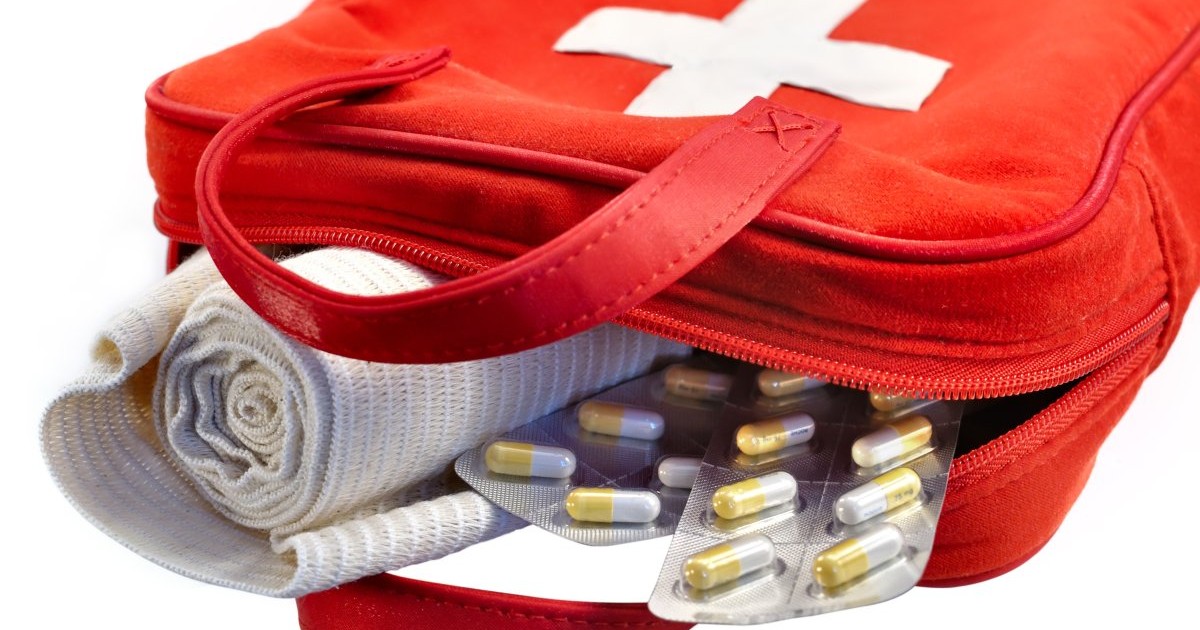A well-stocked first aid kit is essential for responding effectively to common injuries and emergencies that happen near the home. Fortunately, you can find at-home first aid kits with a search online right now.
When used appropriately, they can even save lives. If possible, keep at least one first aid kit in your home, create a smaller version for each of your vehicles and find out where they are located at your workplace.
Getting Started
There are a number of first-aid kits that can be purchased at drugstores or online, or you can assemble your own. A fishing tackle box makes it easy to store your supplies in an organized, portable way, but even something simple like an extra-large Ziploc bag can be suitable for storing first aid supplies.
The Mayo Clinic and the Red Cross recommend that a first aid kit for a family of four should include the following items:
Basic Supplies:
- 2 absorbent compress dressings (5 x 9 inches)
- 25 adhesive bandages (assorted sizes)
- 1 adhesive cloth tape (10 yards x 1 inch)
- 5 antibiotic ointment packets (approximately 1 gram)
- 5 antiseptic wipe packets
- 2 packets of aspirin (81 mg each)
- 1 blanket (space blanket)
- 1 breathing barrier (with one-way valve)
- 1 instant cold compress
- 2 pair of nonlatex gloves (size: large)
- 2 hydrocortisone ointment packets (approximately 1 gram each)
- Scissors
- 1 roller bandage (3 inches wide)
- 1 roller bandage (4 inches wide)
- 5 sterile gauze pads (3 x 3 inches)
- 5 sterile gauze pads (4 x 4 inches)
- Oral thermometer (non-mercury/nonglass)
- 2 triangular bandages
- Tweezers
- Sterile eyewash, such as a saline solution
- First aid instruction booklet
- Plastic bags for the disposal of contaminated items
Medications
- Activated charcoal (use only if instructed by your poison control center)
- Aloe vera gel
- Anti-diarrhea medication
- Over-the-counter oral antihistamine, such as diphenhydramine (Benadryl, others)
- Aspirin and nonaspirin pain relievers (never give aspirin to children)
- Calamine lotion
- Over-the-counter hydrocortisone cream
- Personal medications that don’t need refrigeration
- If prescribed by your doctor, drugs to treat an allergic attack, such as an auto-injector of epinephrine (EpiPen, Twinject, others)
- Syringe, medicine cup or spoon
Emergency items
- Emergency phone numbers, including contact information for your family doctor and pediatrician, local emergency services, emergency road service providers and the regional poison control center
- Medical consent forms for each family member
- Medical history forms for each family member
- Small, waterproof flashlight and extra batteries
- Candles and matches
- Duct tape
- Sunscreen
- Emergency space blanket
- First-aid instruction manual
Give Your Kit Regular Checkups
Once you’ve built a well-stocked first aid kit, make a note on your calendar to check it over at least every three months. Make sure that the flashlight works and replace any medications or supplies that have been used or are expired. It’s also a good idea to regularly update the kit with any personal items such as medications and emergency contacts that may change over time or as your family grows. (You may want to include an up-to-date list of phone numbers for Poison Control, Emergency responders, family members and your family Physician.) Your healthcare provider may have additional suggestions for your family’s unique needs.
Taking It a Step Further:
Basic first aid skills are an invaluable asset to have in an emergency situation. If you’d like to take it a step further, you could consider taking a first-aid course, CPR training or even Cardiac Defibrillator training through a local health agency.
There are also practical measures you can take to prepare your children for medical emergencies in ways that are suited to their age and interests. (For example, you may want to involve them in preparing specialized first aid kits for fishing, cycling or at the cottage.) A number of first-aid manuals and courses can be tailored to help children understand and safely use basic first-aid techniques.
